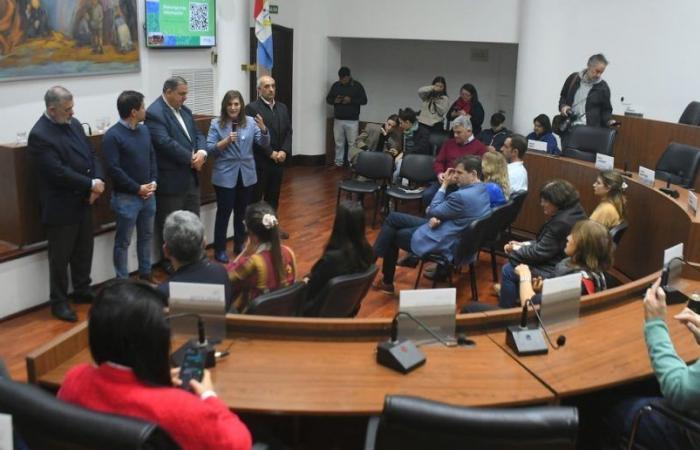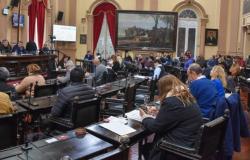
Tuesday 18.6.2024
/
Last update 20:25
On July 4 and 5, a preparatory Forum for the International Habitat Summit of Latin America and the Caribbean will be held in the provincial capital. Only two cities in Argentina were chosen as the venue. One of them is Santa Fe; the other, Mendoza. On the occasion of this event, a formal presentation was held this Tuesday at the local Municipal Council premises.
Cities, as spaces in which the majority of the world’s population lives and as generators of greenhouse gas (GHG) emissions, are also “spaces of opportunity in which many of the challenges of the present can be resolved if with adequate and situated planning that addresses the huge inequalities and their consequences; sustainable urban and metropolitan growth; strong action against climate change and preparation for crises that may arise in the face of new and pressing risks,” the organizers maintain. For this, joint work between local and metropolitan governments, civil society organizations, foundations, academic institutions and the private sector is essential.
What challenges does habitat management entail in a metropolitan context in a geographical environment like ours? What are the barriers and opportunities that lie ahead for sustainable metropolitan development? What role do Local Governments play? Do we have planning and management tools that allow us to adapt to the speed of change and current demands?
See also
See also
More than half of Argentines are interested in environmental issues and recognize climate change
For these and other questions, answers will be sought in the Road to the International Habitat Summit Forum – Santa Fe Chapter, which will take place at the Estación Belgrano Convention Center and will feature the presence of international exhibitors. It is worth mentioning that the Santa Fe headquarters was chosen within the framework of the commemoration of the 30 years of the Constitutional Reform of Argentina, which had it as its headquarters and which opened a new stage in Argentine and Latin American constitutionalism.
The presentation ceremony of the event held this Tuesday in the Council was headed by the president of the local legislative body, Adriana Molina, and by councilor Lucas Simoniello, who is a member of the Advisory Council of the International Habitat Summit of Latin America and the Caribbean -CIHALC-. Also present were the mayor Juan Pablo Poletti; the dean of Fadu-UNL, Sergio Cosentino; and the secretary of International Relations of the province, Claudio Díaz; in addition to the local councilors.
Transformation
“The idea of this event is for us to ask ourselves how we live, what we can change, what we have transformed and what the future of our cities holds for us,” Molina summarized during the presentation, because “the present and the future are the cities. So, how can we not talk about metropolitan development, innovative tools, security, the environment, mobility and territorial planning. These are all topics that we have been discussing for years on this campus and at the university.”
“If there is something I learned in these seven months of management, it is that all organizations are convinced that the real changes are going to be made by local governments,” Poletti said. “From there the transformation will emerge towards where you want to move forward. Therefore, I am glad that this event takes place in Santa Fe.”
Credit: Fernando Nicola
“All the programs that have to be carried out by a local government have to have sustainable objectives, because we must move towards a more sustainable, greener city, with social equality and rights. I don’t say it as demagoguery, I am convinced, because I think what city we are going to leave to our children,” added the mayor.
“We are going to have a very good chapter of the city of Santa Fe in this Habitat Forum for Latin America and the Caribbean,” said Simoniello, in turn. As a member of the Advisory Council, they presented us with the challenge of being able to bring the agenda to our city and quickly, with President Molina and Mayor Poletti, we began to work as a team, articulating actions for this chapter that will be on July 4 and 5.” Simoniello highlighted.
Transfer
“At the university, the habitat issue is, without a doubt, the center of our attention,” said Cosentino. “So our researchers will be here transferring all the knowledge and the key to this meeting, which is the metropolitan area in a sustainable way.”
“Some situation occurs to me. Look at the problems we have today in the Santa Fe metropolitan area due to the inability to resolve something as elementary and important as a bridge to the neighboring town of Santo Tomé,” said Cosentino in relation to the breakdowns suffered by the Carretero bridge and the project. construction of a new parallel viaduct.
See also
See also
From cava to public space: Plaza Marta was inaugurated in the Loyola Sur neighborhood
“In the province we present these days a program that has to do with bringing international relations down to the territory,” said Díaz. This serves “to promote cooperation, technical assistance, banks of good practices and the promotion of networks.”
The event
In the Santa Fe Chapter of the CIHALC, called “Habitat in a metropolitan and sustainable key”, we will seek to generate a dialogue between different actors – academic, government and civil society -, which will allow us to know and understand the scope and forms that they acquire. the risks and threats existing in the territories; exchange learning that emerges from the agendas shared by the region; and jointly investigate practices and opportunities that can be promoted from territorial governance.
See also
See also
World Oceans Day: a commitment to conservation and environmental protection
On Thursday the 4th, inauguration, opening and welcome talks to the Forum will take place, as well as dialogue tables with academic and government authorities and representatives of civil society institutions. The presence of Governor Maximiliano Pullaro – to be confirmed – is planned for the opening; and the Executive Director of the International Habitat Summit of Latin America and the Caribbean (CIHALC), Bernd Pfannenstein; in addition to the aforementioned authorities.
Meanwhile, on the second day of activities, Friday, July 5, panels, conferences and workshops will be held for the community in general. There will be the presence of renowned national and international exhibitors. Likewise, during that second day the 2nd Metropolitan Forum of Councilors will be held simultaneously.
Axes
The Santa Fe chapter will revolve around three axes of work with sub-axes in which all the proposed activities are framed, which in turn represent the work towards achieving the Sustainable Development Goals.
The first axis is sustainable metropolitan development: urban problems and challenges have local and metropolitan scales, as well as opportunities and synergies. In a sustainable development framework, cities and their metropolitan areas present enormous challenges in terms of coordination and governance. At the same time, in a geographical context united by rivers, marshes and lagoons, with interjurisdictional and logistical challenges and common urban agendas, generating spaces to rethink our Habitat and Metropolitan Development is necessary and key.
Credit: Fernando Nicola
The second axis is local innovative tools: in a Latin American context, added to the situation of intermediate cities like ours, we must think about planning, financing and management tools as valuable tools to generate a better quality of life for the inhabitants, improve the fiscal health of the Municipalities and make the interventions from the different actors involved in the urban metabolism more efficient and effective.
And the third axis is urban conflicts as an opportunity: cities are spaces resulting from a complex and dynamic network of actors, processes of anthropization of natural resources, the intersection between territories with lower and higher degrees of vulnerability and a social and cultural framework. that brings those complexities to life. Reflecting on the points of conflict also represents an opportunity to re-think, ponder and focus intervention tools in their resolution.
International speakers
- Architect Cecilia Martínez Leal: She was director of the UN-Habitat office in New York. Martínez has extensive experience in housing, urban planning and urban design, working with communities, the private sector, academia, and national and local governments in Latin America. She has a PhD in Urban Planning from Oxford Brookes University, Oxford, England, in Community Development and master’s studies in urban planning and design from the University of Edinburgh, Scotland. She also has a bachelor’s degree in architecture from the Universidad Iberoamericana de México. Prior to joining the UN-Habitat New York office, Martínez was UN-HABITAT director for the Latin America and Caribbean office, based in Rio de Janeiro, Brazil (2007-2011) and as director of UN-HABITAT Mexico with headquarters in Mexico City (2004-2007). From 2003-2004, she was the Director of the Municipal Public-Private Partnerships Program of the Ministry of Social Development in Mexico.
- Franz Vanderschueren: He has a Doctor in Sociology from La Sorbonne University in Paris, Director of the Center for Urban Security and Director of the Master in urban security, prevention and criminal policy at the Faculty of Law. He has extensive professional experience in crime prevention, he has served as a UN-HABITAT Consultant, IDB Consultant, Founder and Coordinator of the United Nations Safer Cities Program (UN-HABITAT), Technical Advisor for the Urban Management (PGU) of the United Nations (Habitat, World Bank, UNDP) administered by HABITAT in terms of urban poverty reduction and urban crime prevention. This program covered Africa, Latin America, Asia and the Arab Countries. He is currently Coordinator of the advisory group of the Global Network of Safer Cities (UN-HABITAT), 2012-2021, Member of the coordinating unit of the Carabineros de Chile reform (October 2020-2021), Honorary Member of the center’s board of directors Crime Prevention International (Montreal, Canada) (2005-2021).
- Bernd Pfannenstein: A geographer of German origin, he is a teacher, researcher and consultant in Guadalajara, Mexico. His lines of research are focused on topics of urban geography, development and production of urban land, territorial analysis and socio-spatial segregation; He has published articles in indexed scientific journals, author of book chapters. In Mexico he has been assigned as an academic advisor for the UN-Habitat Safer Cities program and the Global Safer Cities Network.





